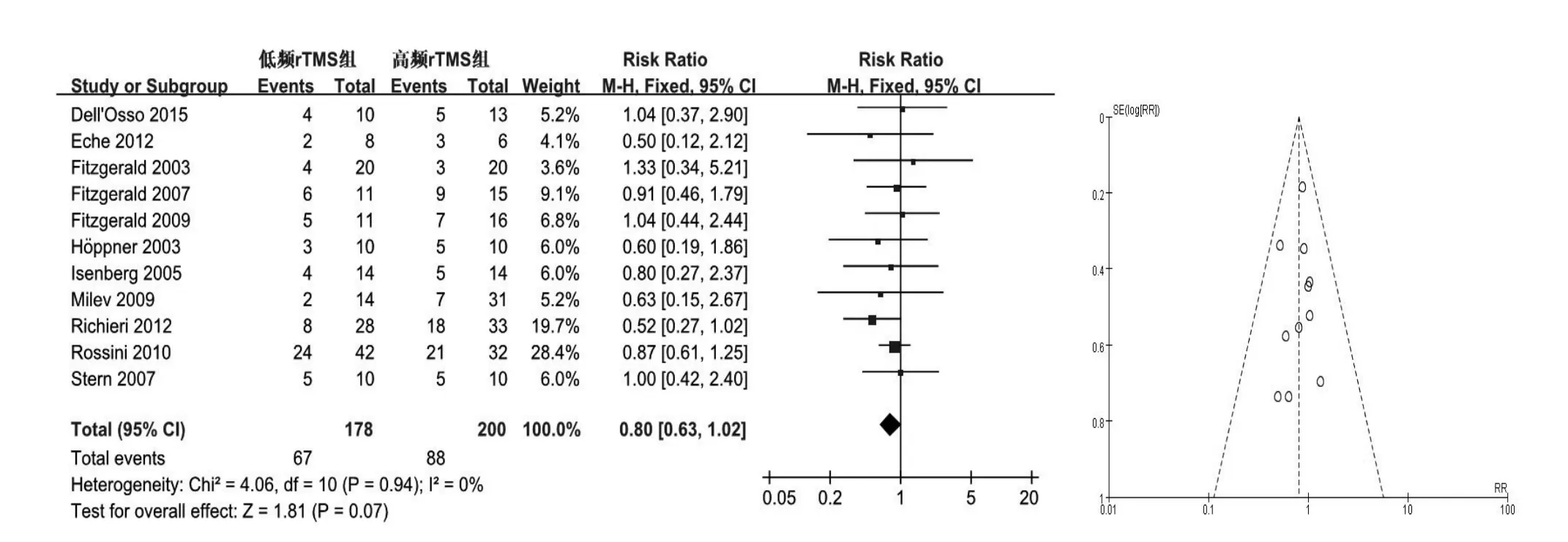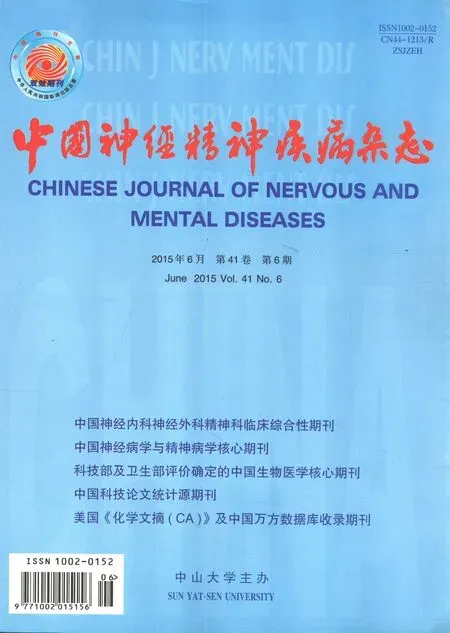右侧额叶低频重复经颅磁刺激治疗抑郁症的meta分析☆
鲁亚杰夏麟武圣君
·论 著·
右侧额叶低频重复经颅磁刺激治疗抑郁症的meta分析☆
鲁亚杰*夏麟*武圣君*
目的系统评价右侧额叶低频重复经颅磁刺激(repetitive transcranial magnetic stimulation,rTMS)治疗抑郁症的疗效。方法检索PubMed、Web of Science、CBM、CNKI、VIP数据库中有关低频rTMS刺激右侧额叶背外侧皮质(dorsolateral prefrontal cortex,DLPFC)治疗抑郁症的临床随机对照研究(randomized controlled trials,RCT)。采用RevMan 5.2软件,根据对照组刺激方法的不同,分别以无效刺激及高频rTMS为对照,对治疗应答率进行meta分析。结果纳入以无效刺激为对照的RCT研究9项,其中低频rTMS组156例抑郁症患者,无效刺激组162例,meta分析显示低频rTMS刺激右侧DLPFC治疗抑郁症,其治疗应答率相比无效刺激组,差异有统计学意义RR=2.15(95%CI:1.57~2.95,P<0.01);纳入以高频rTMS刺激左侧DLPFC为对照的RCT研究11项,其中低频rTMS组178例患者,高频rTMS组200例,meta分析表明两组间应答率差异无统计学意义(RR=0.80,95%CI:0.63~1.02,P=0.07)。结论低频rTMS刺激右侧DLPFC治疗抑郁症有效,但相比高频rTMS刺激左侧DLPFC方法而言,不具有疗效优势。
抑郁症 重复经颅磁刺激 Meta分析
重复经颅磁刺激(repetitive transcranial mag⁃netic stimulation,rTMS)作为一种非侵入治疗抑郁症的方法,近年来引起了临床科研工作者的广泛关注。关于大脑皮层功能的研究表明,抑郁症患者左右侧额叶背外侧皮质(dorsolateral prefrontal cortex,DLPFC)功能失衡,通常左侧功能异常减弱而右侧功能异常增强[1]。有研究证实高频刺激可以增加兴奋,低频刺激可以抑制兴奋[2]。因此高频rTMS刺激左侧DLPFC或低频rTMS刺激右侧DLP⁃FC有望纠正这种失衡而达到治疗抑郁症的目的。目前大量临床试验已经证实高频rTMS刺激对抑郁症的疗效,美国食品药品监督管理局(Food and Drug Administration,FDA)也于2008年正式批准采用10 Hz高频rTMS刺激左侧DLPFC治疗抑郁症。而关于低频rTMS刺激右侧DLPFC的研究报道相对较少,其疗效也不够明确。本研究通过收集已有证据进行meta分析,综合评估低频rTMS刺激右侧DLPFC治疗抑郁症的疗效,及其与高频rTMS刺激左侧DLPFC方法的疗效差异。
1 资料与方法
1.1 文献纳入与排除标准纳入标准:①研究设计类型为临床随机对照试验,且至少为单盲设计;②研究对象为抑郁症患者,诊断以《美国精神障碍诊断与统计手册第四版》(Diagnostic and Statistical Manual of Mental Disorders, Fourth Edition,DSM-Ⅳ)或《中国精神障碍分类方案与诊断标准》(Chinese Classification and Diagnostic Criteria of Mental Disorders,CCMD)为标准,且抑郁量表评分符合抑郁症评价标准,无其他严重精神或躯体疾病;③干预措施为低频rTMS组接受右侧DLPFC低频(≤1 Hz)rTMS,对照组接受无效刺激或左侧DLPFC高频(≥10 Hz)rTMS;④结局指标为汉密顿抑郁评分量表(Hamilton depression scale,HAMD)、蒙哥马利抑郁评分量表(Montgomery-Asberg de⁃pression rating scale,MADRS)或贝克抑郁自评量表(Beck depression inventory,BDI)评价治疗效果,量表改善30%以上视为治疗应答。排除标准:①文献信息不完整或数据有误;②重复文献选取方法学质量较高者;③组间基线资料(年龄、性别、抑郁量表评分等)有统计学差异。
1.2 文献检索检索发表于1995年至2015年2月的文献。英文文献检索PubMed、Web of Science(SCI)数据库,检索词为repetitive transcranial mag⁃netic stimulation、rTMS、depression、frequency;中文文献检索中国生物医学文献数据库(CBM)、中国学术期刊全文数据库(CNKI)、维普数据库(VIP),检索词为抑郁症、经颅磁刺激、rTMS。对所检文献的参考文献进行扩展检索,以减少漏检。
1.3 方法学质量评价采用改良Jadad量表评价纳入文献的方法学质量[3]:①随机序列产生合理;②随机方案隐藏;③盲法;④退出与失访描述清楚。质量评价1~3分为低质量,4~7分为高质量。
1.4 统计学方法通过Cochrane协作网提供的RevMan 5.2软件进行数据分析。采用χ2检验对纳入研究进行异质性检验,各研究满足统计学同质性时(P>0.1,I2<50%),采用固定效应模型对应答率及退出率进行meta分析;反之,则采用随机效应模型。合并效应值为相对危险度(relative risk,RR)及其95%CI。对于纳入文献可能产生的偏倚,采用漏斗图进行评定。敏感性分析选取高质量文献进行。检验水准α为0.05,双侧检验。
2 结果
2.1 文献检索结果检索获得英文文献810篇,中文文献363篇。经筛选,最终纳入17篇:以无效刺激为对照的研究文献9篇,其中英文8篇,中文1篇;以高频rTMS刺激左侧DLPFC为对照的研究文献11篇,均为英文文献。文献纳入与排除情况如图1。
2.2 以无效刺激为对照的meta分析结果
2.2.1 纳入研究的特征 以无效刺激为对照的9项研究共纳入研究对象318例,其中低频rTMS组156例,无效刺激组162例。各研究特征如表1。
2.2.2 应答率的meta分析 低频rTMS组156例患者中治疗应答76例,应答率48.7%;无效刺激组162例患者中治疗应答35例,应答率21.6%。纳入各研究间无统计学异质性(χ2=13.40,P=0.10,I2=40%),故采用固定效应模型进行meta分析。结果显示,低频rTMS刺激右侧DLPFC治疗抑郁症,治疗应答率高于无效刺激组(RR=2.15,95%CI:1.57~2.95),差异有统计学意义(Z=0.48,P<0.01)。漏斗图基本对称,可认为研究结果偏倚较小。见图2。
2.2.3 退出率的meta分析 3项研究描述有研究对象退出,对退出率进行meta分析。各研究间同质(χ2=0.12,P=0.94,I2=0%),采用固定效应模型分析。低频rTMS组退出5例患者,无效刺激组退出13例,两者差异无统计学意义(RR=0.49,95%CI:0.20~1.20,Z=1.57,P=0.12)。
2.2.4 敏感性分析 选取纳入文献中的7篇高质量文献进行敏感性分析,研究间无统计学异质性(χ2=9.60,P=0.14,I2=38%),故选取固定效应模型分析。结果显示,低频rTMS刺激右侧DLPFC治疗抑郁症有效(Z=1.57,P=0.12),低频rTMS组治疗应答率高于无效刺激组(RR=2.01,95%CI:1.44~2.79)。
2.3 以高频rTMS刺激为对照的meta分析结果
2.3.1 纳入研究特征 以高频rTMS刺激左侧DLP⁃ FC为对照的11项研究共纳入研究对象378例,其中低频rTMS组178例,高频rTMS组200例。各研究特征见表2。
2.3.2 应答率的meta分析 低频rTMS组178例患者中治疗应答67例,应答率37.6%;高频rTMS组200例患者中治疗应答88例,应答率44.0%。纳入的研究具有统计学同质性(χ2=4.06,P=0.94,I2= 0%),故采用固定效应模型进行meta分析。结果显示低频rTMS刺激右侧DLPFC的治疗应答率与高频rTMS刺激左侧DLPFC无统计学差异(RR= 0.80,95%CI:0.63~1.02,Z=1.81,P=0.07)。漏斗图对称性良好,认为研究结果偏倚较小。见图3。
2.3.3 退出率的meta分析 3项研究描述有研究对象退出,提取退出数据进行meta分析。各研究间同质(χ2=0.43,P=0.81,I2=0%),以固定效应模型分析。低频rTMS组退出1例患者,高频rTMS组退出3例,两者差异无统计学意义(RR=0.69,95%CI:0.14~3.55,Z=0.44,P=0.66)。

图1 文献纳入与排除流程图
2.3.4 敏感性分析 选取11篇文献中的8篇高质量文献进行敏感性分析,研究同质(χ2=1.75,P=0.97,I2=0%),采用固定模型分析。结果显示低频rTMS刺激右侧DLPFC与左侧高频rTMS相比,治疗应答率差异无统计学意义(RR=0.88,95%CI:0.67~1.17,Z=0.87,P=0.38)。

表1 以无效刺激为对照的纳入研究特征
3 讨论
抑郁症的脑功能障碍主要表现在参与正性情绪调节的左侧DLPFC和参与负性情绪调节的右侧DLPFC发生功能紊乱。有研究证实rTMS可以激活抑郁症患者的DLPFC,高频rTMS刺激左侧DLPFC或低频rTMS刺激右侧DLPFC均有可能通过调节脑功能紊乱达到治疗抑郁症的效果[21]。目前国外已有多项meta分析证实高频rTMS刺激左侧DLPFC治疗抑郁症的疗效。但关于低频rTMS刺激右侧DLPFC的研究较少,且多为小样本研究,其疗效尚未明确。2013年Chen等[22]纳入7项研究对上述两种方法的疗效进行meta分析,结果显示高、低频rTMS疗效无统计学差异。但受限于小样本量原因,此结论有待进一步证实。
本研究关注低频rTMS刺激右侧DLPFC治疗抑郁症的疗效,纳入以无效刺激为对照的RCT研究9项,以高频rTMS刺激左侧DLPFC为对照的研究11项。由于rTMS研究难以做到双盲,因此大多数研究设计仅为单盲。Meta分析显示,低频rT⁃MS刺激右侧DLPFC治疗抑郁症,其治疗应答率与无效刺激相比有统计学差异(RR=2.15,95%CI:1.57~2.95);与高频rTMS刺激左侧DLPFC方法相比,二者应答率差异不具统计学意义(RR=0.80,95%CI:0.63~1.02)。对纳入文献退出率进行meta分析,低频rTMS组与对照患者的退出率的不具统计学差异。以上结果提示低频rTMS刺激右侧DLPFC是治疗抑郁症的一种有效方法,并且其疗
效与高频rTMS刺激左侧DLPFC方法相当。以无效刺激为对照的9项RCT研究中,6项显示低频rTMS刺激右侧DLPFC治疗抑郁症的疗效与无效刺激无统计学差异。出现这种结果一方面是因为研究样本量过小,更重要的是因为抑郁症具有异质性,对于不同类型和不同阶段的抑郁症患者,采取的治疗方案也应有所区别。现阶段rTMS治疗的有效性有限,因此临床应用rTMS需要做到精细化、标准化、个体化,这就要求对刺激部位、治疗周期、刺激频率等参数进行深入研究。

表2 以高频rTMS刺激左侧DLPFC为对照的纳入研究特征

续表2

图2 低频rTMS刺激右侧DLPFC与无效刺激对照应答率的meta分析森林图及漏斗图

图3 低频rTMS刺激右侧DLPFC与高频rTMS刺激左侧DLPFC对照应答率的meta分析森林图及漏斗图
安全性较高是rTMS治疗的重要特征。研究显示,与高频rTMS刺激左侧DLPFC相比,低频刺激右侧DLPFC的安全性更高,不易诱发抽搐,也更容易被患者接受[23]。也有一些研究报道低频rTMS与文拉法辛、舍曲林等抗抑郁药物合并治疗,能够提前药物起效时间,增强药物疗效[24],但rTMS治疗是否需要结合药物还未有定论。临床合理应用低频rTMS还需更多大样本、多中心、随机对照的高质量临床研究提供依据。本研究存在局限性:①研究纳入样本量较小;②各研究的特征存在一定差异,刺激仪器、刺激强度、治疗期间服药情况等不完全一致;③以量表评分为结局指标,纳入文献采用的量表不一,其效度有一定差异。因此本研究所得结论还需深入验证。
[1]Maeda F,Keenan JP,Pascual-Leone A.Interhemispheric asym⁃metry of motor cortical excitability in major depression as mea⁃sured by transcranial magnetic stimulation[J].Br J Psychiatry, 2000,177(2):169-173.
[2]廖力维,王继军.重复经颅磁刺激治疗精神障碍作用机制[J].中国神经精神疾病杂志,2013,39(9):573-577.
[3]Moher D,Pham B,Jones A,et al.Does quality of reports of ran⁃domized trials affect estimates of intervention efficacy reported in meta-analyses[J].Lancet,1998,352(9128):609-613.
[4]Fitzgerald PB,Brown TL,Marston NA,et al.Transcranial mag⁃netic stimulation in the treatment of depression:a double-blind, placebo-controlled trial[J].Arch Gen Psychiatry,2003,60(10): 1002-1008.
[5]Höppner J,Schulz M,Irmisch G,et al.Antidepressant efficacy of two different rTMS procedures:high frequency over left ver⁃sus low frequency over right prefrontal cortex compared with sham stimulation[J].Eur Arch Psychiatry Clin Neurosci,2003, 253(2):103-109.
[6]Januel D,Dumortier G,Verdon CM,et al.A double-blind sham controlled study of right prefrontal repetitive transcranial mag⁃netic stimulation(rTMS):therapeutic and cognitive effect in medication free unipolar depression during 4 weeks[J].Prog neu⁃ropsychopharmacol Boil Psychiatry,2006,30(1):126-130.
[7]Kauffmann CD,Cheema MA,Miller BE,et al.Slow right pre⁃frontal transcranial magnetic stimulation as a treatment for medi⁃cation-resistant depression:a double-blind,placebo-controlled study[J].Depress Anxiety,2004,19(1):59-62.
[8]Klein E,Kreinin I,Chistyakov A,et al.Therapeutic efficacy ofright prefrontal slow repetitive transcranial magnetic stimulation in major depression:a double-blind controlled study[J].Arch Gen Psychiatry,1999,56(4):315-320.
[9]Mantovani A,Aly M,Dagan Y,et al.Randomized sham con⁃trolled trial of repetitive transcranial magnetic stimulation to the dorsolateral prefrontal cortex for the treatment of panic disorder with comorbid major depression[J].J Affect Disorder,2013,144 (1-2):153-159.
[10]Pallanti S,Bernardi S,Di Rollo A,et al.Unilateral low frequen⁃cy versus sequential bilateral repetitive transcranial magnetic stimulation:is simpler better for treatment of resistant depres⁃sion[J].Neuroscience,2010,167(2):323-328.
[11]Stern WM,Tormos JM,Press DZ,et al.Antidepressant effects of high and low frequency repetitive transcranial magnetic stim⁃ulation to the dorsolateral prefrontal cortex:a double-blind,ran⁃domized,placebo-controlled trial[J].Neuropsychiatry Clin Neu⁃rosci,2007,19(2):179-186.
[12]王丽娜,潘飞,李玉凤.低频重复经颅磁刺激对难治性抑郁症的疗效及认知功能的影响[J].中国康复医学杂志,2013, 28(6):544-548.
[13]Eche J,Mondino M,Haesebaert F,et al.Low-vs high-frequen⁃cy repetitive transcranial magnetic stimulation as an add-on treatment for refractory depression[J].Front Psychiatry,2012,3 (13):1-4.
[14]Fitzgerald PB,Sritharan A,Daskalakis ZJ,et al.A functional magnetic resonance imaging study of the effects of low frequen⁃cy right prefrontal transcranial magnetic stimulation in depres⁃sion[J].J Clin Psychopharmacology,2007,27(5):448-492.
[15]Fitzgerald PB,Hoy K,Daskalakis ZJ,et al.A randomized trial of the anti-depressant effects of low and high frequency tran⁃scranial magnetic stimulation in treatment-resistant depression [J].Depress Anxiety,2009,26(3):229-234.
[16]Isenberg K,Downs D,Pierce K,et al.Low frequency rTMS stim⁃ulation of the right frontal cortex is as effective as high frequen⁃cy rTMS stimulation of the left frontal cortex for antidepres⁃sant-free,treatment-resistant depressed patients[J].Ann Clin Psychiatry,2005,17(3):153-159.
[17]Milev R,Abraham G,Hasey G,et al.Repetitive transcranial magnetic stimulation for treatment of medication-resistant de⁃pression in older adults:a case series[J].J ECT,2009,25(1): 44-49.
[18]Rossini D,Lucca A,Magri L,et al.A symptom-specific analy⁃sis of the effect of high-frequency left or low-frequency right transcranial magnetic stimulation over the dorsolateral prefron⁃tal cortex in major depression[J].Neuropsychobiology,2010,62 (2):91-97.
[19]Richieri R,Boyer L,Padovani R,et al.Equivalent brain SPECT perfusion changes underlying therapeutic efficiency in pharma⁃coresistantdepression usingeitherhigh-frequencyleftor low-frequency right prefrontal rTMS[J].Prog Neuropsychophar⁃macol Biol Psychiatry,2012,39(2):364-370.
[20]Dell’Osso B,Oldani L,Camuri G,et al.Augmentative repeti⁃tive transcranial magnetic stimulation(rTMS)in the acute treat⁃ment of poor responder depressed patients:a comparison study between high and low frequency stimulation[J].Eur Psychiatry, 2015,30(2):271-276.
[21]Fitzgerald PB,Uxley TJ,Laird AR,et al.An analysis of func⁃tional neuroimaging studies of dorsolateral prefrontal cortical activity in depression[J].Psychiatry Res,2006,148(1):33-45.
[22]Chen J,Zhou C,Wu B,et al.Left versus right repetitive tran⁃scranial magnetic stimulation in treating major depression:a me⁃ta-analysis of randomized controlled trials[J].Psychiatry Res, 2013,210(3):1260-1264.
[23]Rossi S,Hallett M,Rossini PM,et al.Safety,ethical consider⁃ations,and application guidelines for the use of transcranial magnetic stimulation in clinical practice and research[J].Clin Neurophysiol,2009,120(12):2008-2039.
[24]Rumi DO,Gattaz WF,Rigonatti SP,et al.Transcranial magnet⁃ic stimulation accelerates the antidepressant effect of an itripty⁃line in severe depression:a double-blind placebo-controlled study[J].Biol Psychiatry,2003,57(2):162-166.
Efficacy of low-frequency rTMS to the right frontal cortex for depression:a meta-analysis.
LU Yajie,XIALin,WU Shengjun.School of Psychology,The Fourth Military Medical University,Xi’an 710032,China.Tel: 029-84774826.
ObjectiveTo systematically assess the efficacy of the low-frequency repetitive transcranial magnetic stimulation(rTMS)to the right frontal cortex for depression.MethodsClinical randomized controlled trials(RCT)studies about low-frequency rTMS to the right dorsolateral prefrontal cortex(DLPFC)for depression were collected from database such as PubMed,SCI,CBM,CNKI,and VIP.The meta-analysis using the software of RevMan 5.2 was conducted to com⁃pare the response rate of low-frequency rTMS to the right DLPFC with sham stimulation and high-frequency rTMS to the left DLPFC,respectively.ResultsNine RCT studies with 156 patients in low-frequency rTMS group and 162 patients in sham stimulation group were included.Meta-analysis showed that low-frequency rTMS to the right DLPFC significantly improved response rate compared with sham stimulation(RR=2.15,95%CI:1.57~2.95,P<0.01).Eleven RCT studies with 178 patients in low-frequency rTMS group and 200 patients in high-frequency group were included.There was no significant difference in response rate between the two groups(RR=0.80,95%CI:0.63~1.02,P=0.07).ConclusionThe efficacy of low-frequency rTMS to the right frontal cortex for depression is significant but the efficacy is not superior in comparison with the high-frequency rTMS to left DLPFC.
Depression Transcranial magnetic stimulation Meta-analysis
R749.4
A
2015-02-04)
(责任编辑:肖雅妮)
10.3936/j.issn.1002-0152.2015.06.005
☆ 国家自然科学基金(编号:81401134);陕西省科学技术研究发展项目(编号:2013KJXX-90)
* 第四军医大学医学心理系(西安710032)

